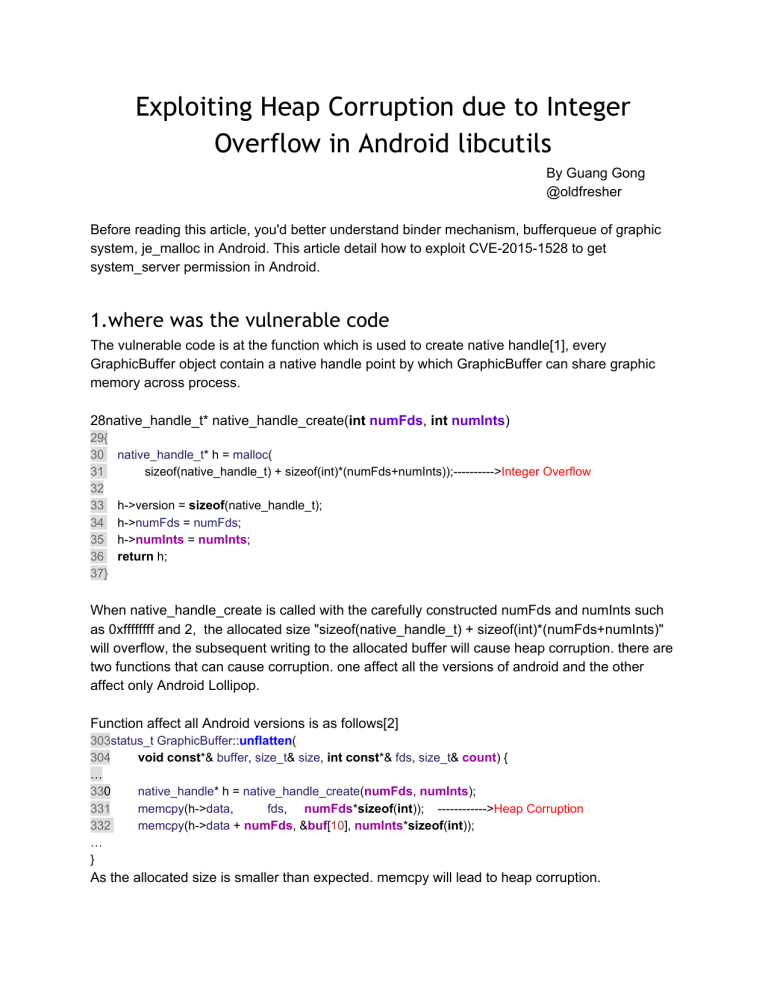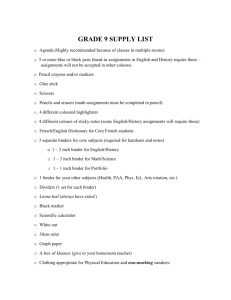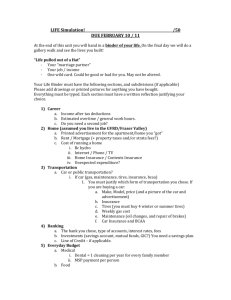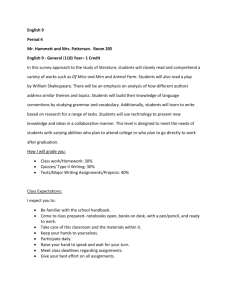Exploiting Heap Corruption due to Integer Overflow in

Exploiting Heap Corruption due to Integer
Overflow in Android
By Guang Gong
@oldfresher
Before reading this article, you'd better understand binder mechanism, bufferqueue of graphic system, je_malloc in Android. This article detail how to exploit CVE20151528 to get system_server permission in Android.
1.where was the vulnerable code
The vulnerable code is at the function which is used to create native handle[1], every
GraphicBuffer object contain a native handle point by which GraphicBuffer can share graphic
memory across process.
28 ( )
29
30
31
(
) + sizeof(int)*( ));>
32
33
34
h>
=
);
35
36
37
h;
When native_handle_create is called with the carefully constructed numFds and numInts such as 0xffffffff and 2, the allocated size "sizeof( )" will overflow, the subsequent writing to the allocated buffer will cause heap corruption. there are two functions that can cause corruption. one affect all the versions of android and the other
affect only Android Lollipop.
Function affect all Android versions is as follows[2]
303 (
304 , , &
…
33
331
332 fds
[
*
(
,
numInts numInts
)); > sizeof
…
}
As the allocated size is smaller than expected. memcpy will lead to heap corruption.
Functions affect only Android Lollipop is as follows[3]this function is defined in all versions of
Android, but it seems to be used only in Lollipop.
1210 ()
...
1219
1220
1221
err
(
());
, numFds
);
1222
1223
1224
.
(h>
err
numFds
; int numInts Heap Corruption
1230
1231
h;
Similar as the previous function, Since the allocated size is smaller than expected. will lead to heap corruption. I will use this function to demonstrate the exploiting process.
To make things worse, numFds,numInts and the buffer to be copied can be manipulated across
process, which means a process with low privilege can write the heap of a process with high privileges using the controlled content, so this is exploitable.
2.the attack vector
If a process can get a binder proxy object with IGraphicProducer interface, this process can exploit the process which hold the real binder object by binder call. The key function to exploit
successfully is setSidebandStream[4] of IGraphicProducer interface.
403
404
405
( stream
, data , );
406 data .
407 create .
408
409 stream
410
411
return
412
NO_ERROR
);
The code above is how
SET_SIDEBAND_STREAM sent by other process, we can see readNativeHandle is called and numFds,numInts and the buffer to be copied can be passed to the attacked process.
the following is a figure of the attack scene.
Figure1.attack scene
3.get system_server permission step by step
After validation, through an normal installed Apps, we can inject arbitrary code into mediaserver, surfaceflinger and system_server in order by this single vulnerability. please note that we have
to take down these three process in order, for example, we get the proper permission to access surfaceflinger if and only if we conquer mediaserver.
Figure2. SELinux domains
Although surfaceflinger run as system user, because the exist of SELinux, surfaceflinger run in domain u:r:surfaceflinger:s0, this domain has little privilege excepting access graphic device, that is why we want to inject into system_server. system_server is the "kernel" of Android,
Although we can't get root permission, we are "halfGod" with the privilege of u:r:system_server:s0 domain. the following figure show by which binder calls e can get system_server permission finally.
Figure 3. Get system_server permission by three steps
As the above figure shows, a normal Application can get an IGraphicProducer interface exposed by mediaserver through querySurfaceMediaSource, so normal Apps can take down mediaserver by setSidebandStream. As process meidaserver have
ACCESS_SURFACE_FLINGER permission, so mediaserver can call createSurface to get An
IGrphicProducer interface exposed by surfaceflinger, so injected code in mediaserver can take down surfaceflinger. surfaceflinger calling IWindowsManager.screenShotApplication will trigger system_server call captureScreen of ISurfaceComposer, which will call back to surfaceflinger with an argument IGraphicProducer expose by system_server, so the injected code in surfaceflinger can take down systemserver using this interface.
4.the detail of exploiting mediaserver
We have to take three steps to get system_server permission and each step is difficult as the exist of NX, ASLR, SELinux and multiple binder server threads combined with je_malloc features. I'll just show how to exploit media_server. Simply put, there are steps to exploit
mediaserver
1)control binder server threads
As we know, every thread is associated with a specific arena when using je_malloc[5], heap memory required in different threads will be allocated using different arenas, so, the small
memory allocated by different threads will be put in different chunks(In Android, the size of chunk is 1MB). Figure 4 shows the discreteness of the heap in je_malloc.
Figure 4.heap distribution in je_malloc
binder server threads serve the binder call from binder clients, the number of binder server threads increase with the synchronous calling from the binder clients. the count of binder server
threads in media server start with 4 and can be increased to 17 eventually.
Figure 5.binder server threads in mediaserver
when a binder call is sent to mediaserver, system choose a binder server thread randomly to handle this call, in addition, different threads allocate memory in different thunk, so it's impossible to manipulate heap(heap FENGSHUI) by binder call if so many binder server thread are active. the solution is block all the binder server threads except one, so the definite thread will be chosen to handle the binder call and we can do heap fengshui. IGraphicProducer can be used to attach GraphicBuffer to bufferqueue. every bufferqueue can only store a specific amount of GraphicBuffer. when the count of attached buffer is larger than the specific amount,
the binder server thread will enter wait state and not handle other binder call,so we can use attachBuffer in IGraphicProducer to put binder server thread in wait thread.
2) leak heap content
Because the exist of ASLR, we need to leak address information from mediaserver. In je_malloc, same size memory allocation occupy the adjacent region, not like dl_malloc, there are no metadata between regions. we can allocate many normal native_handle in mediaserver by attachBuffer. The structure of native_handle_t is as follows, the allocated size is decided by numFds and numInts(in nexus 5, numFds is 2 and numInts is 12, and the allocated size is 80)
(gdb) pt native_handle_t type = struct native_handle {
int version;
int numFds;
int numInts;
int data[4294967296];
} umFds and numInts can be modified to a bigger value by setSidebandStream, when requestBuffer is called to get buffer associated with the modified native_handle, more heap
memory will be leaked to the attack process.
Figure 6.leak heap memory from mediaserver
As the above Figure shows, numFds and numInts of the attacked native handle are modified to
0 and 0x10000. when the GraphicBuffer associated with this handle is request by the attacker,
4*0x10000 bytes from 0xb396074c will be leaked from media server.
3)leak stack base address
Because the exist of NX, we need to use ROP to bypass it. ROP need to control the content of stack. If the stack base address can be leaked, we can use the vulnerability mentioned above to rewrite stack, so we can convert the heap corruption vulnerability to stack overwrite.
We already know how to leak memory from heap, so we can search heap to get the stack base address. The key structure to accomplish it is pthread_internal_t.
0xb652ecbc: 0xb6e4700d 0xb3d48960 0x00000000 0xae7dd000
0xb652eccc: 0x00000001 0x00000000 0x00000000 0x00000000
0xb652ecdc: 0x00000000 0x00000000 0x00000000 0x00000000 the above address range shows the content of an pthread_internal_t, from which we know tid is
0xb58, pid is 0xa53, thread stack base is at 0xae7df000. So, we can get stack base address by search the leaked heap memory. the magic to search are stack_size(0x000fe000) and guard_size(0x00001000). As we know, generally new created thread has bigger thread id. New binder server thread are created when there is no thread available to handle the binder call. So, we can find several pthread_internal_t and choose the one with the biggest thread id, we have a maximum probability of finding the binder server thread which is in wait state. The stack backtrace of the waiting binder threads are known, it's as Figure 7, we can rewrite the return address to trigger the execution of ROP.
Figure 7.stack backtrace of the blocked thread
4)leak base address of shared library
We need the base address of shared libraries to execute ROP. it's easy to leak the base address of libui.so. Then only thing we need to do is find a GraphicBuffer from the leaked heap.
There is a sub structure named android_native_base_t inside GraphicBuffer. we can caculate the base of libui.so from the function point incRef and decRef.
(gdb) pt/m android_native_base_t type = struct android_native_base_t {
int magic;
int version;
void *reserved[4];
void (*incRef)(android_native_base_t *);
void (*decRef)(android_native_base_t *);
it's better to get base address of libc.so to write shellcode. the GOT of libui.so contain the memcpy address, from which we can calculate the base address of libc.so. But it's a little difficult to read the content of the GOT because we can only leak specific size of contiguous memory from heap by modifying numFds and numInts, there are unmapped memory between heap address and the libui.so. I find another method to leak the content of libui.so.
GraphicBuffer contain the point of native handle, if this point is modified to point to a faked native handle, we can leak the memory following the faked native handle. the size of the leaked memory is up to the numFds and numInts of the faked handle. we can get dlopen and dlsym
address by reading the GOT of libc.so and use them in shellcode.
5)control the next allocation position of je_malloc
By construct specific numFds and numInts, we can only write the memory near native handle, as the stack is not adjacent to heap generally. We need to find a way to write to stack to trigger
ROP.Luckily we can convert this vulnerability to write arbitrary value to arbitrary address by modifying the point table of tcache thread cache in je_malloc. small objects, this cache is stored in a structure named tcache_t. there are a point tables for every size class. When allocate small objects, je_malloc first try to find a cached memory in a specific point table. there are 31 size classes for small objects in the realization of je_malloc in
Android, refer to the following gdb output.
(gdb) p je_small_bin2size_tab
$24 = {8, 16, 24, 32, 40, 48, 56, 64, 80, 96, 112, 128, 160, 192, 224, 256, 320, 384,
the point tables of tcache is allocated in heap mixed with other normal allocated memory, so we can modify them. The following gdb output show one point table of tcache. When objects larger than 112 bytes and smaller than or equal 128 are allocated, this point table will be use. ncached1 is the index of next allocated point of specific size. We can modify this value to point to stack, then when we allocated memory of specific size, the stack address will be returned, and writing to the allocated buffer will overwrite stack. So, we can execute ROP in the stack.
(gdb) p je_arenas[0].tcache_ql.qlh_first.tbins[11]
$9 = {tstats = {nrequests = 17}, low_water = 62, lg_fill_div = 1, ncached = 63, avail
= 0xb6003f60}
(gdb) x/63xw je_arenas[0].tcache_ql.qlh_first.tbins[11].avail
0xb6003f60: 0xb6057f80 0xb6057f00 0xb6057e80 0xb6057e00
0xb6003f70: 0xb6057d80 0xb6057d00 0xb6057c80 0xb6057c00
0xb6003f80: 0xb6057b80 0xb6057b00 0xb6057a80 0xb6057a00
0xb6003f90: 0xb6057980 0xb6057900 0xb6057880 0xb6057800
0xb6003fa0: 0xb6057780 0xb6057700 0xb6057680 0xb6057600
5.bypass SELinux to load so
Because the exist of SELinux, The file created by the normal application with label of app_data_file or apk_data_file. media server have no sepolicy to load binary with these label. So system and dlopen can't be use to execute binary in mediaserver. luckily, media has execmem permission allow mediaserver self:process execmem; >SELinux policy we can use mprotect to modify anonymous memory to executable so we can execute shellcode. I implement a mechanism of loading so from memory in shellcode in my PoC(that is complicated and i won't detail it in this article), So shared library with label app_data_file or apk_data_file can be passed to mediaserve as binary stream by the vulnerability, and then be loaded from memory.
Figure 8. load shared library in mediaserver
As media server has no permission to execute /system/bin/sh, I also inject busybox to media server so we can execute simple command. If exploit successfully, we can get a shell from media server.
Figure 8. Shell with mediaserver permission
6. exploit surfaceflinger and system_server
Exploiting exception.
1
2.the module base addresses are the same between system_server and normal application as they both are forked by Zygote process, it's not necessary to leak them.
I've implement the whole exploit process in my PoC. the link of the PoC is at https://github.com/secmob/PoCForCVE20151528
[References]
[1]http://androidxref.com/5.0.0_r2/xref/system/core/libcutils/native_handle.c#29
[2]
[3]
[4]
03
[5]http://www.phrack.org/issues/68/10.html









